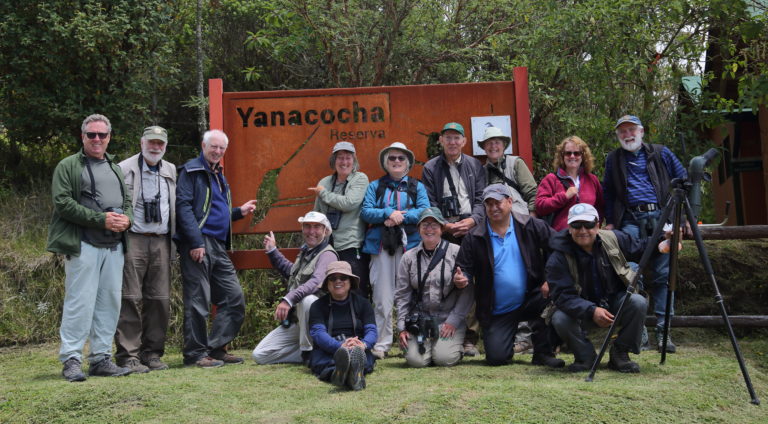
We begin on a bumpy road winding along the bottom of the Rio Alambi valley. Deep in the valley is the Alambi Lodge, where the garden birds have to be seen to be believed. A couple of logs laden with bananas attract a steady stream of frugivores like Golden, White-lined, Lemon-rumped, Bue-grey and Palm Tanagers, plus Golden-olive Woodpecker, Thick-billed and Orange-bellied Euphonias, Bananaquit and Buff-throated Saltator. However, this is a side show to a dozen or so hanging sugar feeders, which attract a mind-blowing frenzy of hummingbirds, amounting to literally hundreds, all buzzing, whirring and twittering within feet of the verandah! Amongst the staggering melee our brilliant local guide Juan Carlos points out a dozen different species of spectacular ‘hummers’; White-whiskered Hermit, White-necked Jacobin, Brown and Sparkling Violetears, Crowned Woodnymph, Andean and Western Emeralds, Fawn-breasted and Green-crowned Brilliants, Purple-bibbed Whitetip, Rufous-tailed Hummingbird, the flamboyant White-booted Racket-tail and the tiny Purple-throated Woodstar, which hovers like a bee. What a dazzling star-studded show that was. Imagine having that lot on your garden list! Meanwhile, a stroll down to the river adds Black Phoebe and Torrent Tyrannulet to the list. Higher up the valley J C spots a female Cock-of-the-rock sitting tight in her nest tucked into the roadside bank at eye level. Next we visit the Bellavista reserve in towering pristine forest, up in the clouds at around 7300 feet above sea level, where ‘car park’ birds include White-tailed Tyrannulet, Golden-crowned Flycatcher, Speckled Hummingbird, Dusky Brushfinch, Blue-and-white Swallow, Buff-tailed Coronet, Masked Flowerpiercer and Rufous-collared Sparrow, while restaurant sightings over lunch include White-sided Flowerpiercer, Toucan Barbet and a busy pair of Cinnamon Flycatchers, all right outside the windows. After lunch, we also spot a male Green-and-black Fruiteater and Montane Woodcreeper here. Moving on, a couple of strolls in the nearby forest produce sightings like Russet-crowned Warbler, Black-eared Hemispingus, White-tipped Dove, the beautifully marked Pearled Treerunner, a fiery Crimson-mantled Woodpecker and a posing male Masked Trogon. Journey’s end is the lovely Septimo Paraiso lodge near Mindo, where Brown Inca and Violet-tailed Sylph are new for the trip.
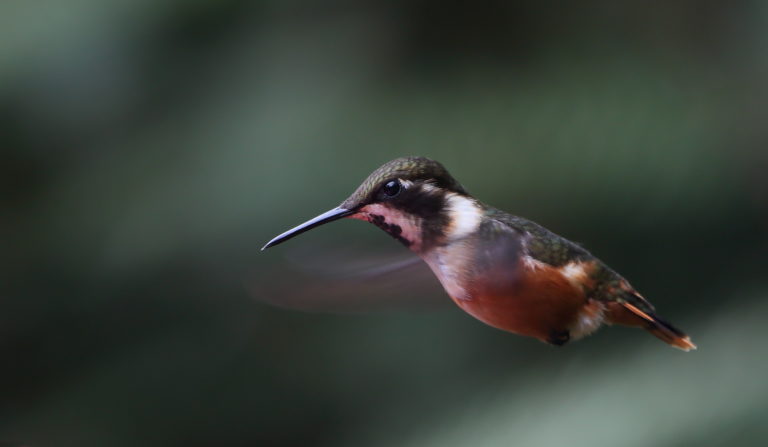
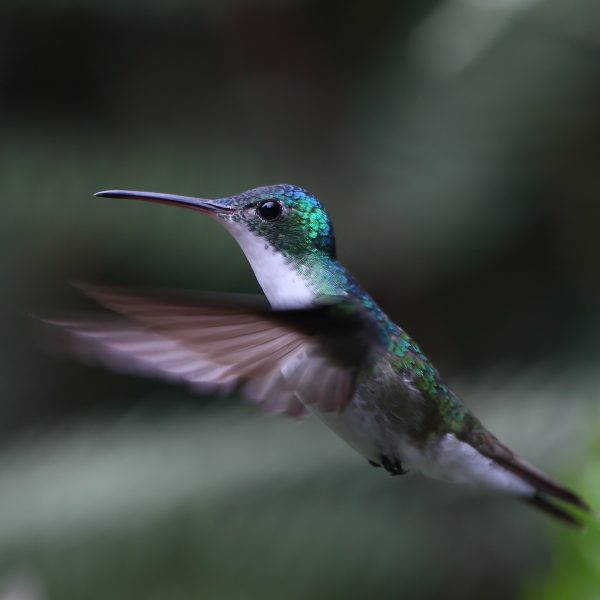
Today we visit the Mashpi Conservation Area, with extensive cloud forest ranging from 2470 to 5610 feet above sea level. This is part of the Choco region with 22 regional endemics. Arriving at the Amagusa mirador shortly after day break, clouds drifting across the wooded slopes create an ethereal atmosphere amongst the tall trees, festooned with thick mosses and red-flowering Bromeliads, where early birds include a pair of Swallow Tanagers and a very obliging Golden-headed Quetzal, posing for the cameras on a nearby branch. Our first stroll along the dirt road produces a steady stream of new sightings such as Slate-throated Whitestart, Zeledon’s Antbird, Buff-fronted Foliagegleaner, a delightful little Ornate Flycatcher and a sunbathing Rufous-browed Peppershrike, plus Red-faced Spinetail, Olive-crowned Yellowthroat and Rusty-margined Flycatcher, as well as a very slender fourteen inch snake resting on the track. Next stop is at the Amagusa smallholding, with a very lively feeding station, attracting Lemon-rumped, Golden-naped, Rufous-throated, Flame-faced, Moss-backed and Golden Tanagers, as well as the well named Glistening-green Tanager and the lovely Golden-collared Honeycreeper. Meanwhile the hanging sugar feeders are buzzing with twittering ‘hummers’ like Green Thorntail, Purple-bibbed Whitetip, Velvet-purple Coronet, Violet-tailed Sylph and Empress Brilliant. Further along the dirt road, with Black and Turkey Vultures and a Barred Hawk overhead, we find a stunning male Orange-breasted Fruiteater, one of the local endemics. Moving on, a second feeding station adds Crimson-rumped Toucanet to the growing list. Strolling amongst a variety of colourful butterflies we meet a mixed feeding flock with birds like Scaly-throated Foliagegleaner, Spotted Woodcreeper, Russet Antshrike, Choco Warbler, a female One-coloured Becard and a stunning male Red-headed Barbet. After a picnic lunch, we nail the wolf whistling Barred Puffbird and find the rare and striking Scarlet-and-white Tanager along with Grey-and-gold Tanagers, followed by a male Masked Tityra, Silver-throated and Ochre-breasted Tanagers, and a very well concealed male Choco Trogon, with a green breast and a deep red belly. A pair of Red-rumped Woodpeckers and a couple of colourful Choco Toucans, feeding on tiny fruits with their awesome bills, round off another productive day.
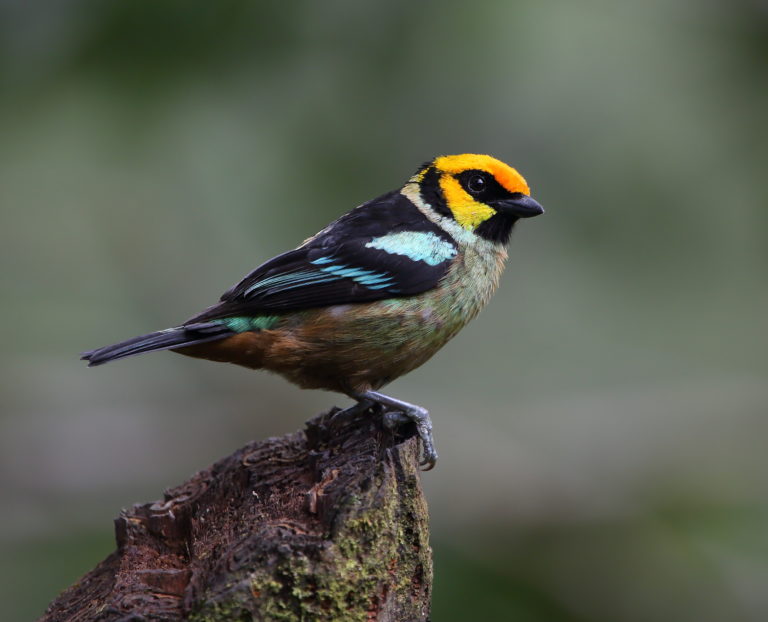
We set off at first light for a visit to a nearby Cock-of-the-rock lek, and as we descend the path towards the display area, we can already hear their raucous squawks and squeals, sounding rather like strangled pigs. Once in position, we witness the spectacular performance of around a dozen vivid scarlet males, with bizarre pompoms on their foreheads and high on testosterone, bowing, wing-flapping, and occasionally locking beaks and plummeting to the ground. The spectacle continues for over an hour, and they do this from dawn, every morning throughout the year! As the action dies down, a Dark-backed Wood-Quail emerges from the undergrowth, making a bee line for a banana placed on a mossy branch, just a few feet away, by our host, Angel Paz, the legendary ‘Antpitta man’. Angel has several more treats in store, beginning with another banana placed on the ground a little further along the road, which instantly brings out a pair of Dark-backed Wood-Quail, along with a chick. A calling Cloud Forest Pygmy-Owl pinpointed in J C’s scope draws us away from the Wood-Quails, while Angel and his brother Rodrigo begin to work their magic with their ‘pet’ Antpittas, which they have been ‘training’ with whistles and worms for the past fourteen years! Apparently, it takes three to four solid months, every day, to train each bird! Rodrigo beckons us to line up in the middle of the track, ready to meet Maria, a Giant Antpitta the size of a chicken, who suddenly pops up on a log at the edge of the track, enticed by a small pile of diced worms! Wow, how lucky we are today, as she had recently been playing ‘hard to get’, and not seen for the previous ten days! With handshakes all round, Maria is an undoubted contender for ‘star bird’ of the trip. At the end of the dirt road, with graceful Swallow-tailed Kites circling across the verdant valley, a track leads into the cloud forest at over 6000 feet, where Angel places a few worms on a log, whistles softly, and encourages his next invisible ‘pet’ into view with a softly spoken “Venga, venga, venga”. Wilhelmina, a gorgeous Yellow-breasted Antpitta patters along the log, like a supermodel on a catwalk, complete with whirring cameras, making several encores! Next, we move on for nice views of Band-tailed Pigeon and the multi-coloured Plate-billed Mountain-Toucan. Retracing our route down to Angel’s house, a narrow path descends into the forest home of an Ochre-breasted Antpitta called Shakira, so called because of her unusual habit of twisting from side to side like a singer! No, I am not making this up! That’s first class views of three Antpittas by 11.30am! Back at Angel’s house, brunch is served on a balcony with a panoramic view of the forested valley down below, and cracking close eye level views of a colourful selection of birds like Lesser Violetear, Blue-winged Mountain-Tanager and Slate-throated Whitestart, plus Palm, Golden, Flame-faced and Golden-naped Tanagers.
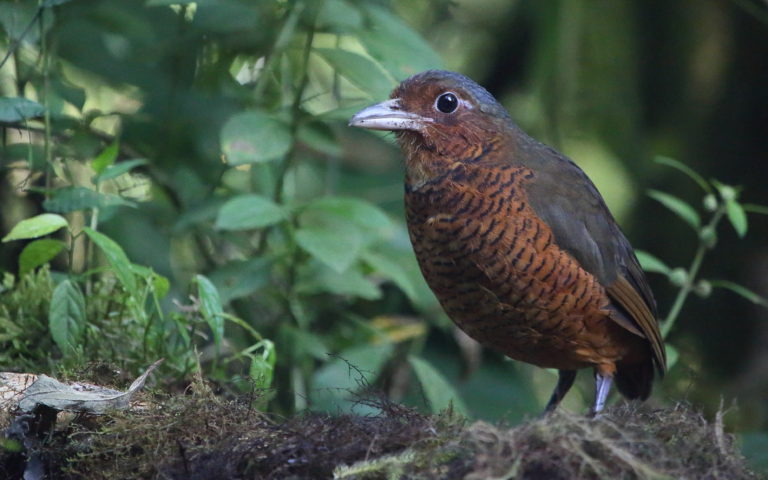
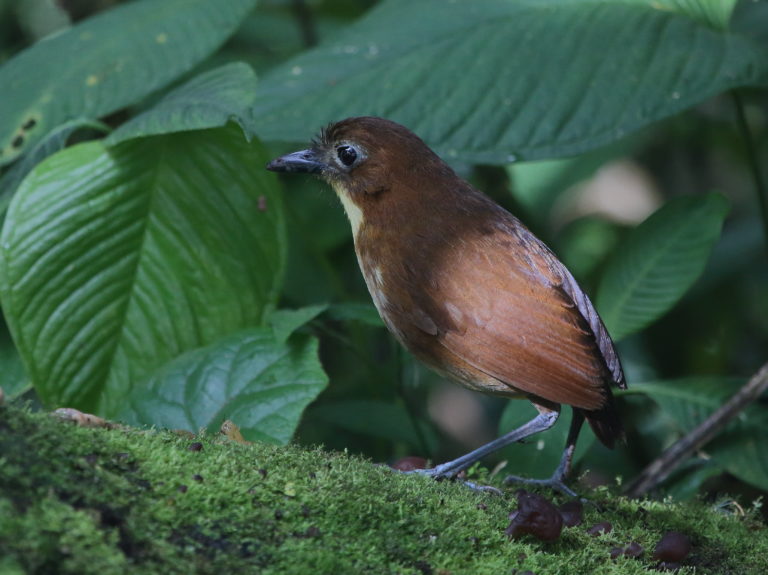
From here, it’s a slow, winding, bone-shaking drive through stunning forested mountain scenery on a dirt track, which would normally be considered unsuitable for heavy vehicles, with long drops on either side, and yet Edgar, our driver makes it all look so easy. Journey’s end is the Guallabamba Valley, in time for a late lunch along with birds like Pacific Hornero, Social Flycatcher, Sothern Beardless and Yellow-crowned Tyrannulets, Rufous-collared Sparrow, Scrub Blackbird and Yellow-faced and Blue-black Grassquits. Deep in the valley, with White-collared Swifts swarming overhead, a narrow chasm is used as a roosting site by Oilbirds, a bizarre fruit-eating member of the Nightjar family which usually roosts in caves, but here they are starring at us from their ledges just a few feet above our heads in broad daylight! What a fabulous day’s birding, with the added bonus of an Andean Olingo (a nocturnal arboreal frugivorous mammal) in the grounds after dinner.
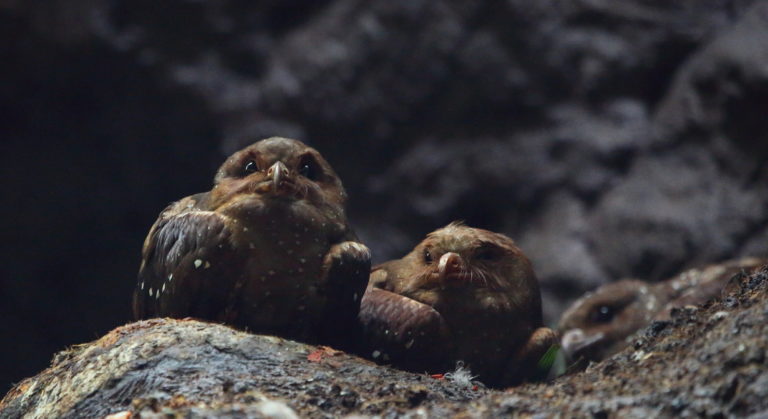
We set off before dawn this morning, for Río Silanche, where we enjoy a picnic breakfast with a busy little Buff-rumped Warbler close by. The main attraction here is a tall tower offering eye level views of the forest canopy, where we soon get close views of Green Honeycreeper, Ruddy Pigeon, Yellow-throated Toucan, Rufous-winged Tanager and a stunning male Yellow-tufted Dacnis. For the best part of two hours a steady stream of sightings appear every few minutes, including in order of appearance, Lesser Greenlet, Choco Tyrannulet, a lively pair of Dot-winged Antwrens, Palm and Tawny-crested Tanagers, Rose-faced Parrot, Blue-necked and Golden-hooded Tanagers, and a superb juxtaposition of nearby Choco Toucans and Pale-mandibled Aracaris, while the stream of new birds continues with a pair of White-tailed Trogons, Blue-headed Parrot, a perched Crane Hawk and a male Masked Tityra. Back down to earth, a short stroll in the forest produces Pallid Dove, Western Woodhaunter, White-flanked Antwren, Plain Brown Woodcreeper and a striking female Guayaquil Woodpecker, as well as some stonking Bullet Ants. Next stop is at the nearby Rancho Suamox, an impressively bird-rich back garden, where new sightings include Purple-chested Hummingbird, Silver-throated and Dusky-faced Tanagers, Tropical Gnatcatcher, Maroon-tailed Parakeet, Masked Water-Tyrant, Black-cheeked Woodpecker, Band-tailed Barbthroat, Scarlet-rumped Cacique and the rare Brown Wood-Rail. That’s quite a garden list for a short visit.
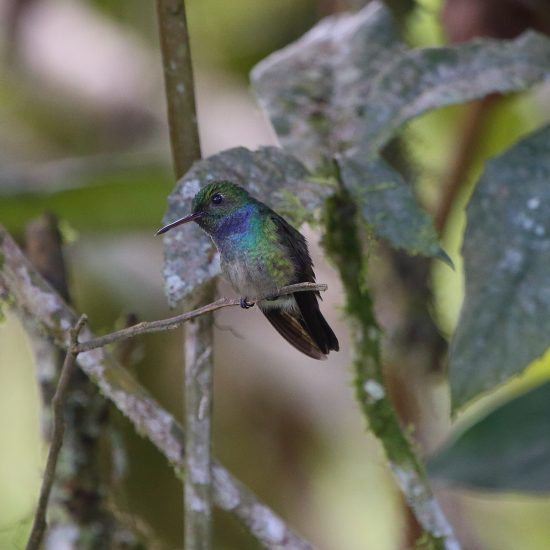
After lunch back in ‘seventh heaven’, we explore ‘downtown’ Mindo, where the garden birds include Social and Bran-coloured Flycatchers, Slaty and Red-faced Spinetails, Blue-and-white Swallow, Ecuadorian Thrush, Fawn-breasted Tanager, Yellow-bellied Seedeater, Dull-coloured Grassquit, Tropical Parula, Scarlet-backed Woodpecker, the tiny Olivaceous Piculet, and the humbug-patterned Pacific Antwren, as well as a Hook-billed Kite in the same view as a spectacular Rufous Motmot. At dusk, J C has a couple more treats in store; firstly, a male Lyre-tailed Nightjar, singing from a bare branch, with a remarkable curly tail, which is more than double the length of its body! This remarkable sighting is another definite contender for bird of the trip, followed by an impressive Black-and-white Owl caught by torchlight on an open perch. Wow!
Sadly it’s time to leave Septimo Paraiso, early again, on another bumpy road alongside a clear fast flowing río, with nice views of White-capped Dipper, en route to the Yanacocha cloud forest reserve, where, at around 11300 feet, the air is preciously scarce, and yet the hummingbirds here have no problem pursuing their enormously energetic lifestyles. A selection of feeders here attract higher altitude species, such as Shining Sunbeam, Tyrian Metaltail, Buff-winged Starfrontlet, Mountain Velvetbreast, Sapphire-vented and Golden-breasted Pufflegs with fluffy white ‘boots’, the hefty Great Sapphirewing, with a six inch long body which chases all the others, and the unique Sword-billed Hummingbird, with an incredibly long ‘lance’ for a bill, which is actually longer than its body! It has to be seen to be believed. Other visitors to the feeders include Masked and Glossy Flowerpiercers, Great Thrush and Yellow-breasted and Grey-browed Brushfinches, plus Black-chested and Scarlet-bellied Mountain-Tanagers. Beyond the feeders, a level track follows the contours of the vertiginous forested slopes, where new sightings include White-throated Tyrannulet, Spectacled Whitestart, Smoky Bush-Tyrant and a Tawny Antpitta, actually hopping along the track ahead of us, like a long-legged, tailless juvenile Robin! Almost back at the start of the trail, as we start to discuss tomorrow’s cunning plan, with the likelihood of seeing Condors, what should appear in the blue sky above us? Yes, an Andean Condor! How ironic is that?
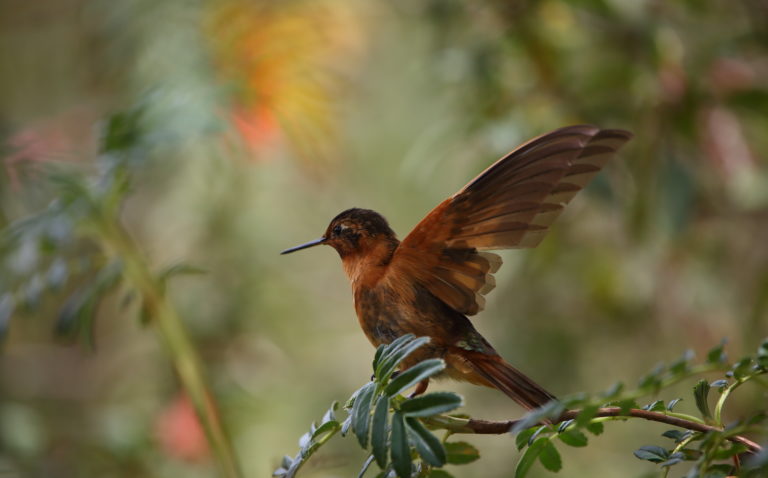
Now that we have acclimatised to high altitude, we aim high with a visit to Antisana, a snow-capped volcano reaching 18891 feet above sea level, but first, J C has a surprise in store with a detour into the Papallacta Pass. Not far out of the Quito valley, we pull over to scan the slopes and ‘hey presto’ there is a Spectacled Bear! In the scope we can clearly see this spectacular, almost mythical creature tearing into Bromeliads with its powerful claws, while sitting half way up the hill side. After such a phenomenal start to the day, anything else would be a bonus! Back on track for Antisana, we stop for a welcome cup of hot tea at the Tambo Condor Restaurant, where new birds on the terrace include Black Flowerpiercer, Giant Hummingbird, and the amazing male Black-tailed Trainbearer, a hummingbird with a tail longer than its body! Driving ever higher, a stop at a bridge over a fast flowing stream in a landscape reminiscent of the North Pennines, produces sightings of Brown-bellied Swallow, Black-winged Ground-Dove and a male Ecuadorian Hillstar, showing an iridescent indigo head in the scope, each time it returned to its favourite perch, below rocks described by Lynne as two buttocks! This will forever be recorded in the birding annals as ‘Bumcrack Rock’! Onward and upward, at the next stop we find Plumbeous Sierra-Finch and both Stout-billed and Chestnut-winged Cinclodeses, feeding close by on the short Paramo turf, along with Paramo Ground-Tyrant, and a Grass Wren, looking like a short-tailed version of ‘our’ Sedge Warbler. Moving on, we meet a group of Variable Hawks and a Black-chested Buzzard-Eagle hanging on the breeze. At over 13,000 feet, the scenery is literally breathtaking, with Antisana’s rugged snow-clad pinnacles disappearing into the clouds. New sightings continue to appear in the open treeless Paramo landscape, including Andean Lapwing, Gull and Ibis, plus Carunculated Caracara and small herds of White-tailed Deer. Where the road ends at Laguna Mica, we also spot another showy Tawny Antpitta as well as an obliging Many-striped Canastero, along with Silvery Grebe, Yellow-billed Pintail and Andean Teal and Coots on the lagoon, with two Andean Condors soaring along the distant skyline. Back at the restaurant in time for lunch, we are also just in time to watch another Condor showing off its white ruff and long white wings as it soars against the whitewashed cliffs where it roosts near the aptly named Tambo Condor restaurant. Back at the Casa de Campo, we have some free time to reflect on today’s fabulous experiences.

By the end of this wonderfully productive and memorable trip, we had seen over 230 species of birds, including a staggering 37 different Hummingbirds! Along the way we had witnessed some truly spectacular experiences, such as all those rainbow-coloured Tanagers, the amazing variety of dazzling Hummingbirds, the Oilbirds at arm’s length, the exotic Cocks-of-the-rock, the Antpitta ‘show’, the singing Lyre-tailed Nightjar, and of course, the Spectacled Bear.
